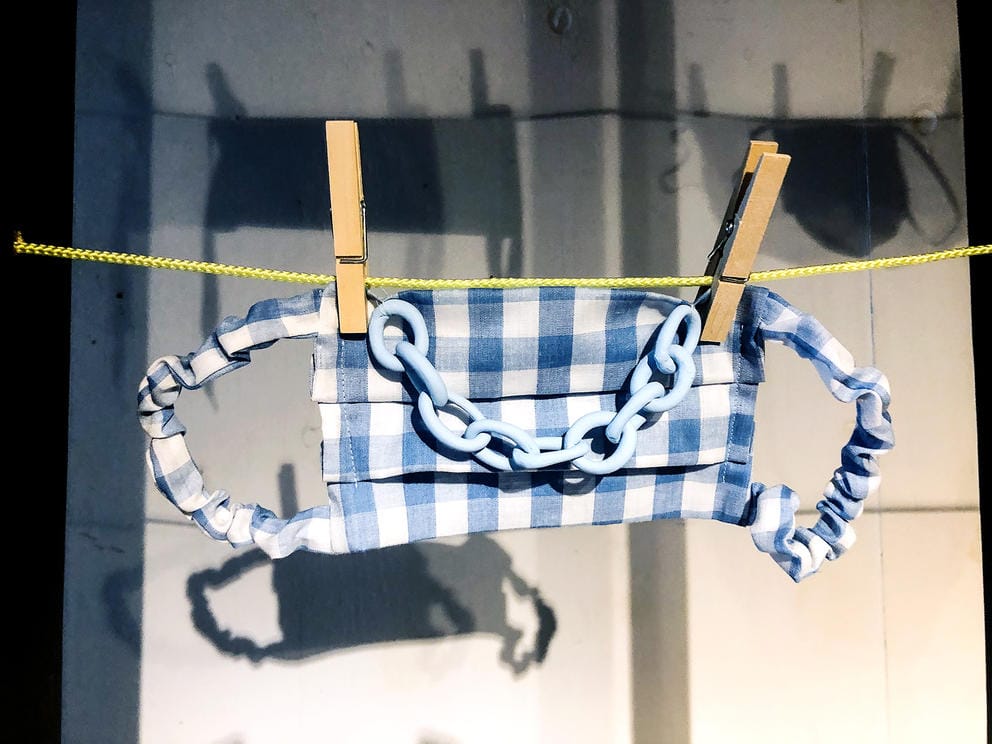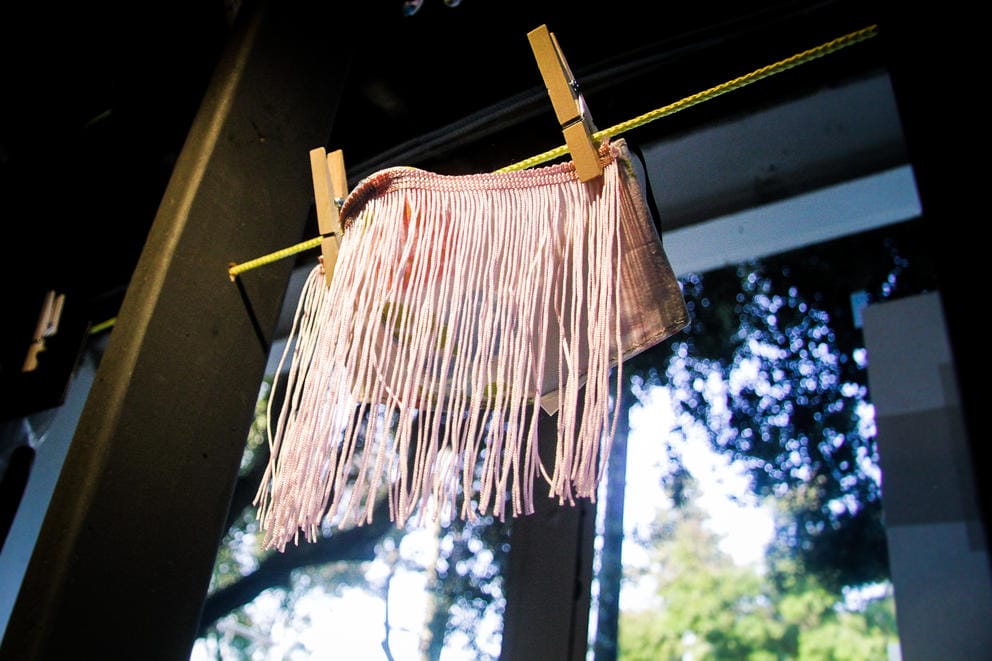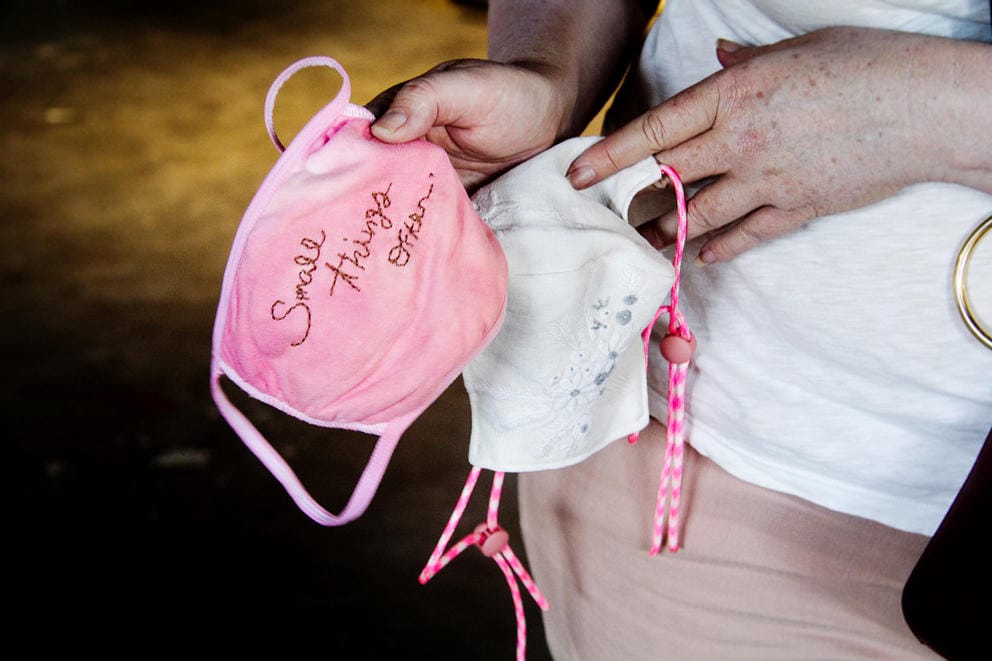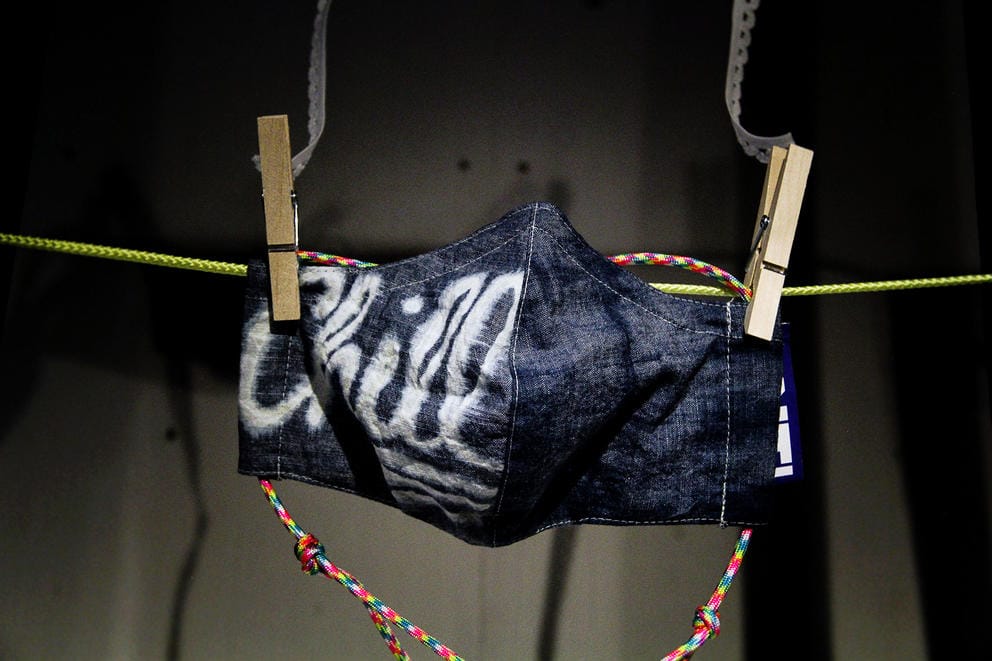On a recent Thursday afternoon at the Museum of Museums, an art enthusiast approaches a flamingo-pink mask clothespinned to a neon-yellow cord. Though touching is prohibited, he can’t resist — the dangling fringe beckons him forward, like a fortuneteller behind a beaded curtain. He runs his fingers through the pink strands.
“Like Orville Peck,” he says to his wife, referring to the alt-country music crooner famous for anonymizing himself with a series of eye masks featuring extra-long fringe. But this mask, made by Seattle artist Mary Anne Carter, is supposed to cover the nose and mouth. The fringe here is intended to put a different spin on a piece of cloth that has become near-synonymous with 2020.
The mask is one of several hundred in Mask Parade, a new pop-up art show at the Museum of Museums, the long-awaited contemporary art space set to open officially this October. (Consider this exhibit a pandemic proof-of-concept.) The mission: 30 artists each make 30 masks and sell them for $30 a pop. The show runs Sept. 18-20 and all proceeds go to the youth arts nonprofit Coyote Central.
The show’s simple setup belies what is perhaps a milestone for masks: Roughly six months after the Centers for Disease Control and Prevention and the Washington State Department of Health started recommending cloth face coverings for the public, the now-ubiquitous accessory is getting upgraded to art object — adding another layer to its function as a safety measure and, to a lesser extent, fashion accessory.
“We’re in Phase 3 of masks,” says Seattle fashion designer and multimedia artist Cole Pillitu, “of what masks can be and exist as and function as and look like.”

“I imagine they would be something straight out of a Sophia Coppola movie set during a pandemic,” Timothy Rysdyke, Museum of Museums manager and co-curator of “Mask Parade,” says of masks by Gillian Martinez. (Margo Vansynghel/Crosscut)
Unlike the glamorous, golden “museum worthy” face masks actress Tilda Swinton recently took for a spin on the Venice Film Festival red carpet (causing a bit of a stir), the face coverings on display here are both fanciful and functional.
Pillitu started airbrushing and hand-dyeing bed sheets and other fabrics for mask-making purposes early on in the pandemic. With a serious chronic respiratory disease, Pillitu knows how important masks are. But, to an artist, they’re also a literal blank canvas.
“There are infinite formats to explore,” Pillitu says. “I was thinking today, I want to make a puffer coat this winter and make a matching puffer coat ‘face hood’ or puffy mask — like a ski jacket mask.”
If that sounds outlandish, a visit to Mask Parade will surely expand your protective-face-covering horizons. You can acquire a white leather mask shaped like a fanny pack (courtesy of designer Siobhan Teahan). Or a pink silk number (by Gillian Martinez), the perfect accompaniment to an evening gown, maybe a negligée. Others are adorned with dainty fringes and frills, including a few whimsical pastel masks by Martinez and local artist Idalis Madrigal.

Seattle artist Mary Anne Carter started sharing her eccentric mask designs in a series of Instagram selfies earlier this spring as an art project. Now, some of her more "COVID-compliant" masks are on view (and for sale) at Museum of Museums. (Margo Vansynghel/Crosscut)
“I imagine they would be something straight out of a Sophia Coppola movie set during a pandemic,” Timothy Rysdyke, Museum of Museums manager and co-curator of the show, says of Martinez’s masks.
Madrigal, a local artist who works with fabric and ceramics, patchworked her masks using vintage fabric and beloved ribbons she inherited from her grandmother, who also taught her how to sew. These masks, Madrigal tells me, are somewhat of a tribute. “I feel like she would have wanted me to use them for something as important as this,” Madrigal says.
Some masks at the Parade might look understated in contrast, but are by no means less labor intensive. Local writer Drew Zandonella-Stannard opted for simpler, one-layer cotton masks, but embroidered them freehand with Insta-worthy quotes, including the pandemic-appropriate “Please scream inside your heart.” Local artist-designer Janelle Abbott, known for her Wardrobe Therapy project, painstakingly hand-painted horses and cutesy flowers on each of her masks.
But the visitors assembled Thursday at the Museum of Museums (in socially distanced groups of five, that is) are not looking for understated. They reach for colorful parrots and bold patterns, fringes and gold lamé. Now that we’re all doing with less in order to save lives, more, it turns out, is more.

A “Mask Parade” visitor displays two masks, one by Drew Zandonella-Stannard, who embroidered masks freehand with Insta-worthy quotes. (Margo Vansynghel/Crosscut)
The fringed and stage-jewelry adorned masks are in particular demand. Within an hour of the show's opening, three visitors have snatched up Mary Anne Carter originals. (For those wary of masks fondled by other hands: MoM provides a sanitizing UV lightbox.)
Carter started sharing her eccentric mask designs in a series of Instagram selfies earlier this spring as an art project. The Cindy Sherman-like effort (wigs and all) was a way to keep making art during the isolated early days of spring lockdown. Her original outrageous masks were not really made to be worn. In some cases, that would be impossible — for instance, the mask Carter made out of her grandmother’s long white gloves, which she carefully stuffed and manicured with red nails. Another is made out of a clear, glittery vinyl casing filled with pastel pink and baby blue Wellbutrin pills.
But the masks she contributed to MoM, even though highly aesthetic, are, as Carter puts it, “COVID-compliant.” By which she means masks you can actually wear comfortably. “You want people who buy them to actually have a mask that they can use, and not necessarily an object that they can, I don't know, put on the wall or frame.”
Nonetheless, Carter has been hanging her own creations on sconces in her apartment and encourages everyone to display their masks as art, if they feel so inclined.
Whether you call the cloth creations at Mask Parade art or not, Carter says, “It’s a unique timestamp of what we're going through — because the subject matter is a very literal representation,” she says.
It’s also one of the first returns to the art world camaraderie since the pandemic took away art walks and other cultural events. “Being part of the art community was interacting in person and that's been removed,” Carter says. “But the idea of having a group show … even just the idea of having a lot of artists together kind of returns to that feeling of collaboration, connectivity. That is the thing I've missed most in quarantine.”

Like many creatives, local denim designer Catherine Palpallatoc has pivoted to mask making during the pandemic under the brand name Anti Anti-mask Club. (Margo Vansynghel/Crosscut)



